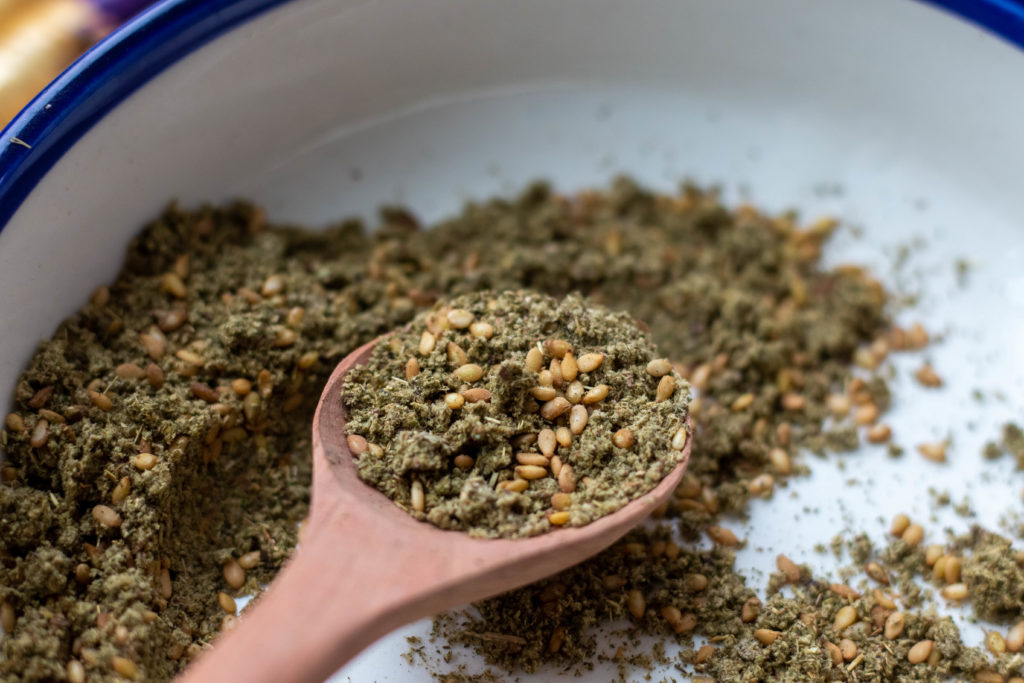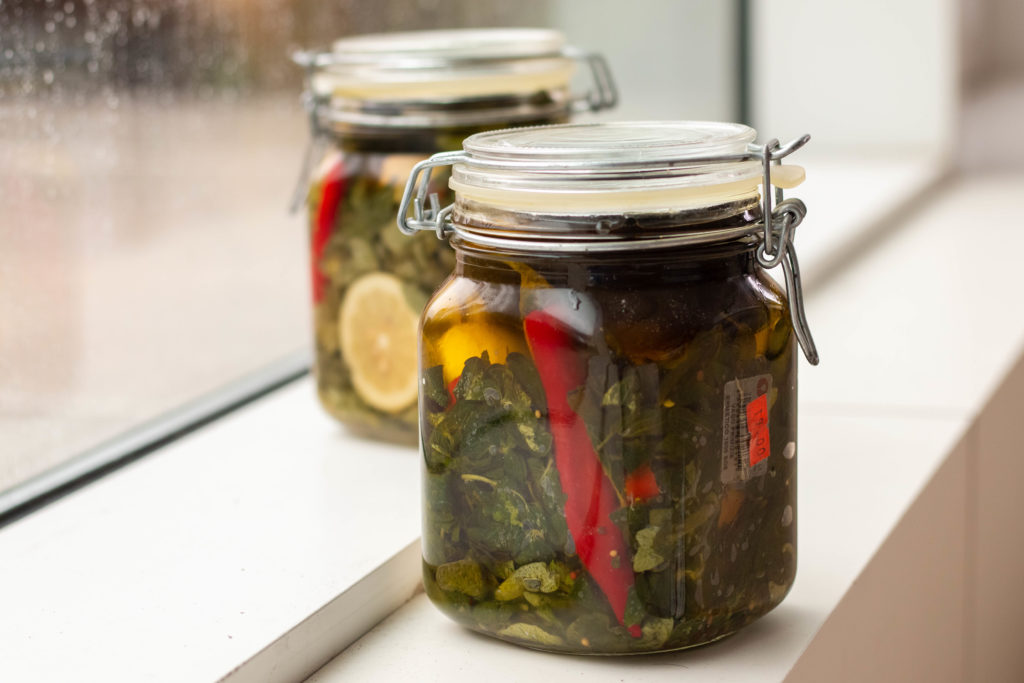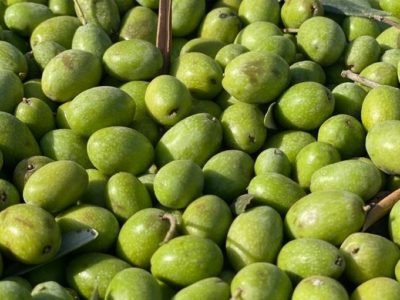زعتر حملت سلتي, ابقل العليق والمرار, واللوف مبرد اللسان, يلذعه مبردا,والزعتر الممنوع
“I carried my basket, gathered raspberry and bitter herbs, and also the arum, which stings the tongue with its tickling itch, and the forbidden za’atar.”
— Hanna Abu Hanna, 1988
When I was in school, my mother used to make pitas drenched in olive oil and za’atar in the mornings before exams, sometimes adding labneh. The radiant green colored the paper that wrapped the pitas, even spreading to the rest of the bag at times. Like many Arabs, she believes za’atar improves memory and brain function. As a university student, I continued to make the same sandwich during the exam period — and, thankfully, it seemed to help.

Every local kitchen is home to a jar — or several — of za’atar, a quintessential local spice and spice blend by the same name; it’s used in to top salads, cheeses, and eggs in the morning, worked into doughs for afternoon snacks, used to add depth to roast meats at dinner, and even to add an earthy and tangy undertone to modern desserts. To me, like many Palestinians, eating and making za’atar is a crucial cultural tradition, the ultimate scent of winter, and deeply connected to my childhood memories.
What Is Zaatar?
Like other ingredients of Arab cuisine, which received their name from the dish in which they are used (like malfouf the word for cabbage, which comes from the name for cabbage rolls), the origanum syriacum, a wild herb that grows on mountains and plateaus of our area, is named after the popular spice mixture made with tangy sumac and nutty sesame seeds. Fresh za’atar can be found year-round, but its leaves are at their peak in winter and spring. In late summer the plant blooms, and picking isn’t recommended – both because of the pungent taste of the leaves and the danger of damaging the plant’s ability to reproduce.

In his “Book of Local Food,” Dr. Uri Mayer-Chissick writes that origanum syriacum has been one of the most prominent and important herbs of our area throughout history, “besides being the important ingredient of the famous spice mixture, it is a central herb in local traditional medicine – Arab and Jewish, and it is mentioned in the Bible as a purifying substance.”
Za’atar is also frequently mentioned in ancient medicine and culinary books, where it is called saatar. “Kitab al-Ṭabīḫ,” the oldest surviving Arabic cookbook, which comes from the 10th century, refers to the drying and heating qualities of the herb, used to support the digestive system, as well as for treating phlegm, season meat, and to “lighten” heavy dishes. Scattering za’atar around the house was and still is considered an effective method of pest control, especially for snakes and scorpions. “Kitab al-Ṭabīḫ” also shares a recipe for “tayeb salt,” a za’atar-like seasoned salt, which is mixed with dried za’atar, dried pomegranate seeds, toasted sesame, and breadcrumbs. It is interesting to note that the distinction between cultivated za’atar (za’atar bustani) and wild za’atar (za’atar bari) was already known at the time. And two centuries later, Ibn Al-baytar, an Andalusian physician, pharmacist and scientist in his book “The Benefit of Foods,” “the bustani is weaker in medicinal qualities but better for cooking and easy to use.”
Mom’s Season
Whereas olive season is my favorite, the za’atar season is clearly my mother’s season, and at the height of winter it seems her hands are tattooed in green from picking and separating the leaves of the za’atar plants growing in her yard. She lays the separated leaves on sheets spread in every room of the house, and the air is filled with the strong scent of local za’atar.
When I was a child, the preparation process began on a sunny day in mid-winter, when we set out to pick the wild plant. A short ride in a crowded car from our home in Kafr Qara brought us to the green area called called Alwarha, or Ramot Menashe, near the ruins of the uprooted Palestinian villages Sabbarin and Umm al-Shawf. It is one of the country’s most beautiful and fertile areas, where nature penetrates each cell of the body with the scent of damp soil, fennel, and za’atar.
We picked za’atar with great respect and awe for the soil. Our day began with a rapid survey of the territory to locate the za’atar bushes naturally growing between the rocks; then, our backs bent, as if surrendering to the plants, we selected the freshest, most succulent branches, with the largest and greenest leaves, and picked them with care to protect the roots for future seasons. We would spend the day picking za’atar and other plants, such as Jerusalem sage, gundelia, fennel, arum and sorrel, and return home at dusk for the second, labor-intensive stage, separating the leaves.
A pile of za’atar branches was placed at the center of the room, and with what seemed like innate skill, we started working expectantly: we knew a feast of kras (za’atar pitas) or fatayer would be waiting for us the next day. While baking in the wood-fired taboon, the scent of this olive oil-rich, za’atar and onion stuffed pastry filled the entire neighborhood, attracting a growing number of guests to join the feast.

The other half of the separated leaves was used to make what is called dukkah in the Galilee and Lebanon , and known as the za’atar spice blend in many communities. The verb “duk” in Arabic means to pound, referring to any mixture of pounded spices. This simple, yet unique spice is common throughout the Levant. The Egyptian doa (the k is pronounced as a in Egyptian Arabic) is made with roasted chickpeas, sesame, peanuts and spices. In Gaza, it is made of lentils, dill seeds, sumac and toasted wheat, and the Syrian version is similar, with a generous addition of za’atar. Our dukkah is identical to the Lebanese version: the dried za’atar leaves are pounded with toasted heirloom sesame and fresh sumac picked during summer. The za’atar mixture is used all year round, giving pastries, salads and main dishes their signature local flavor.
Picking Zaatar: A Political Action?
In the article “A Zaatar-Soaked Battle,” za’atar expert and attorney Rabia Agrabia writes: “The za’atar mixture is an essential part of every Palestinian kitchen. It is a symbol for simplicity, an almost indispensable ingredient, even at times of deprivation. For this reason, it is frequently mentioned in Palestinian speeches and slogans as a symbol for a quality staple food which signifies the Palestinian bond with the land.” It is rooted in folk poems and songs like Mahmoud Darwish’s 1976 piece “Ahmed Zaatar,” written in the aftermath of the massacre in the Palestinian refugee camp Tel al-Zaatar in Beirut. Here, za’atar is a central to the work, symbolizing a Palestinian who had lost his homeland and his connection to the land.
In 1977, za’atar was included on Israel’s list of protected plants, and the traditional practice of picking wild za’atar was forbidden by law under heavy penalties. The Arab population perceived the law as anti-Palestinian. Continuing to pick it, on a smaller scale, was and is viewed as an act of resistance and protest.
The law raised doubts, as it seemed to lack a clear scientific justification, and the gathering of za’atar continues in neighboring countries. Lebanon, for example, issued a special permit for gathering up to five kilograms of za’atar (after drying), and the plant remained a prominent feature of the local landscape. In his article, “An Invisible Fence: Gathering Edible Wild Plants as Traditional Ecological Knowledge Versus Israeli Nature Conservation Laws,” foraging scholar Yatir Sade claimed that a ban on gathering would not prevent the plant’s extinction. Adding: “In some cases, it could have the adverse effect, as the criminalization of gathering excludes traditional gatherers (usually women), leaving the traders (usually men), who do not necessarily abide by traditional gathering practices that protect plant reproduction.”
According to the website of Adalah (the legal center for Arab minority rights in Israel), the Israel Nature and Parks Authority announced the cancellation of the za’atar law in 2019, lifting all limitations on gathering the herb. Yet two months later, as enforcement continued, it announced that gathering would be limited to 200 grams in natural reserves, or 1.5 kilograms in open fields. In response, Agrabia said: “after senior officials in the Nature Authority had made numerous declarations in the media, promising no limitation on akkoub [za’atar] gathering, now, with opening of the akkoub season, it turns out the Authority continues taking action against gatherers, contrary to the policy paper it had only recently published.”
In an interview with Globesprofessor Nativ Dudai, a veteran researcher of origanum syriacum and the head of the Aromatic and Medicinal Plants Unit at the Volcani Center, claimed the state should impose severe punishments on those who gather za’atar for commercial purposes. He also mentioned the amount of za’atar uprooted during construction projects, such as infrastructure or road paving, which causes far greater damage than gathering for domestic consumption.
In recent years, gatherers have witnessed a decrease both in the amount and quality of wild za’atar, which is thought to be a result of the ban on gathering and the “goat law,” which prohibits local goats from grazing in nature. In the past, natural trimming by gatherers and goats had strengthened the plants and helped them grow fresh branches in the following year. Today, most za’atar is grown as an agricultural crop.
Zaatar in the Palestinian Kitchen
In the local kitchens of Palestine, Syria, Lebanon and Jordan, za’atar is traditionally used in pastries such as the fatayer, cheese-filled ones called maujanat, or in savory or sweet biscuits. The fresh leaves are added to salads, such as one with orange, wild fennel and jibneh (soft white cheese) salad we used to make for family picnics. They are also used in meat stews, and when cooking grains such as rice, freekeh (roasted green wheat), and bulgur. I particularly like to make a dish of roasted chicken flavored with fresh za’atar leaves, sumac and olive oil. The leaves can be preserved by drying, freezing or curing with spices like garlic, chili pepper, mustard, cilantro and lemon in a salt solution or olive oil.

This month I’m sharing a classic recipe for a pastry known by many names including kras za’atar, falaheen’s za’atar, motabak za’atar, and simply za’atar. A savory hand pie, it’s stuffed with za’atar leaves and spring onions, and made with plenty of olive oil. It’s common in the Triangle area in the north, in Tulkarm, Jenin, and Jerusalem. My mother’s recipe uses chopped onion, fried in olive oil, with finely chopped za’atar leaves. The following is my mother-in-law’s version — she makes the best za’atar pitas with spring onions and whole za’atar leaves, which add a strong aroma.
The second recipe is for strawberry and za’atar crumble, a combination of two winter ingredients. I used a few drops of orange blossom water and some orange peel in the strawberry mixture, and added a tablespoon of olive oil to enhance the aroma. Other seasonal fruits may also be used to substitute for the strawberries.


